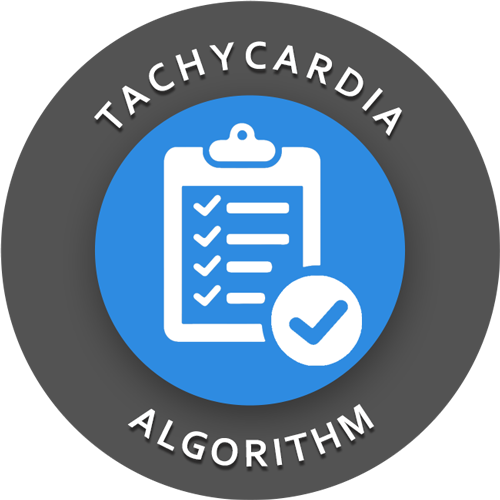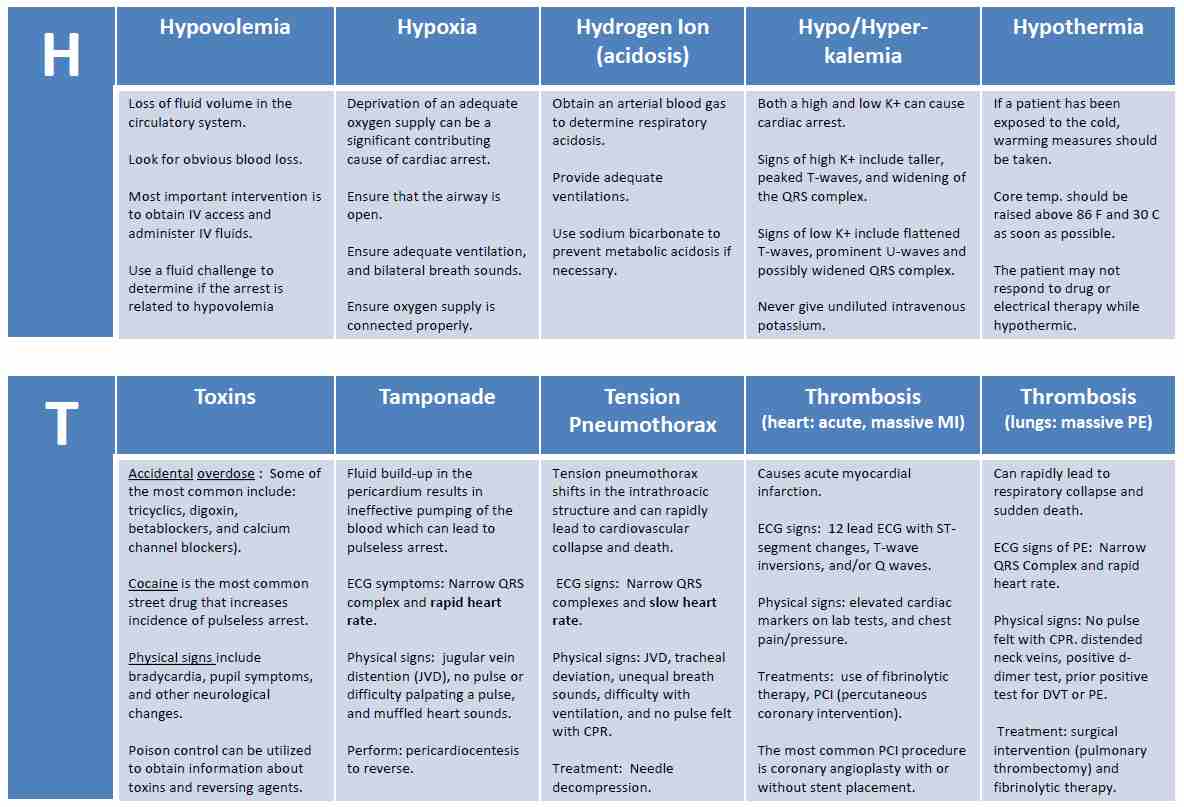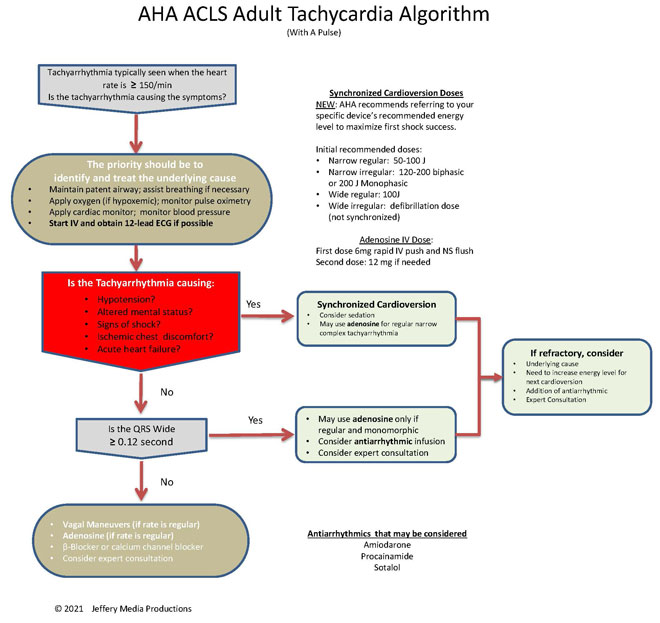 Tachycardia/tachyarrhythmia is defined as a rhythm with a heart rate greater than 100 bpm.
Tachycardia/tachyarrhythmia is defined as a rhythm with a heart rate greater than 100 bpm.
An unstable tachycardia exists when cardiac output is reduced to the point of causing serious signs and symptoms.
Serious signs and symptoms commonly seen with unstable tachycardia are: chest pain, signs of shock, SOA (short of air), altered mental status, weakness, fatigue, and syncope.
One important question you may want to ask is: “Are the symptoms being caused by the tachycardia?” If the symptoms are being caused by the tachycardia treat the tachycardia.
Causes
There are many causes of both stable and unstable tachycardia and appropriate treatment within the ACLS framework requires identification of causative factors. Before initiating invasive interventions, reversible causes should be identified and treated.
The most common causes of tachycardia that should be treated outside of the ACLS tachycardia algorithm are dehydration, hypoxia, fever, and sepsis. There may be other contributing causes and a review of the H’s and T’s of ACLS should take place as needed.
Click below to view the H and T’s table. When done click again to close the diagram.
H’s and T’s Table

Administration of OXYGEN and NORMAL SALINE are of primary importance for the treatment of causative factors of sinus tachycardia and should be considered prior to ACLS intervention.
Once these causative factors have been ruled out or treated, invasive treatment using the ACLS tachycardia algorithm should be implemented.
Associated Rhythms
There are several rhythms that are frequently associated with stable and unstable tachycardia these rhythms include:
- Supraventricular tachycardia (SVT)
- Atrial fibrillation
- Atrial flutter
- Monomorphic VT
- Polymorphic VT
- Wide-complex tachycardia of uncertain type
ACLS Treatment for Tachycardia
Click below to view the tachycardia algorithm diagram. When done click again to close the diagram.
Tachycardia Diagram

or Members Download the Hi-Resolution PDF Here(This will open in another window.)
The first question that should be asked when initiating the ACLS tachycardia algorithm is: “Is the patient stable or unstable?” The answer to this question will determine which path of the tachycardia algorithm is executed.
Unstable Tachycardia
Patients with unstable tachycardia should be treated immediately with synchronized cardioversion. If a pulseless tachycardia is present patients should be treated using the cardiac arrest algorithm.
The AHA no longer provides specific shock dose recommendations for synchronized cardioversion. Instead, they instruct to refer to your specific device’s recommended energy level to maximize first shock success.
For the purposes of a basic understanding of cardioversion, the information about general shock dosages and recommendations will remain in the content on this website.
The initial recommended synchronized cardioversion voltage doses are as follows:
- narrow regular: 50-100 J; i.e., SVT and atrial flutter
- Narrow irregular: 120-200 J biphasic or 200 J monophasic; i.e., atrial fibrillation
- Wide regular: 100 J; i.e., monomorphic VT
- Wide irregular: defibrillation dose (not synchronized)
Stable Tachycardia
Patients with stable tachycardia are treated based upon whether they have a narrow or wide QRS complex. The following flow diagram shows the treatment regimen for stable tachycardia with narrow and wide QRS complex.
- Stable (narrow QRS complex) → vagal maneuvers → adenosine (if regular) → beta-blocker/calcium channel blocker → get an expert
- Stable (wide/regular/monomorphic) → adenosine → consider antiarrhythmic infusion → get an expert
Olivia Howden says
Hi Jeff! I’m having difficulties differentiating the types of supra ventricular tachycardias (i.e. AVNRT vs ANRT), what causes a narrow vs. wide complex tachycardia, as well as the indications for adenosine. Why is adenosine only used if the rate is regular, narrow and monomorphic and anti arrhythmic meds used for wide QRS tachycardias?
Thank you kindly.
ACLS says
Hi Olivia,
SVT (AVNRT) vs. VT it’s a complex topic and beyond the scope of ACLS. This webpage will give you more detail regarding differentiation between SVT vs VT.
SVT Article 1
SVT Article 2
This webpage does a very good job of explaining the role and the importance of adenosine and also the contraindications and also absolute contraindications.
Adenosine
Kind regards, Jeff
Sabrina says
Can we give adenosine to a patient with atrial fibrillation? If not what are the rhythms we can use it for only . And what drugs do we usually give when a person has atrial fibrillation and complaining of symptoms
ACLS says
Adenosine can be used to slow down the heart rate temporarily with atrial fibrillation and atrial flutter. This can allow proper identification of rhythms when the rate is extremely fast. Adenosine will not solve the problem in this situation.
The only tachyarrhythmia that adenosine will be effective for is SVT.
Medications that would most likely be used with rapid ventricular rate atrial fibrillation with a rapid ventricular that is causing symptoms would be medications like beta blockers and calcium channel blockers which slow conduction and muscle contraction and therefore slow the heart rate.
Kind regards,
Jeff
sabrina says
do anti-arrthymic drugs ever reset rhythm like a shock could or do they reduce the rate and affect the ecg rhythm that way?
ACLS says
Antiarrhythmic drugs do not reset the rhythm like a shock does. Different antiarrhythmic drugs have different pharmacological effects on the myocardium to reduce the chances of ventricular tachycardia and ventricular fibrillation.
Kind regards,
Jeff
Sabrina says
Hi why do we avoid av nodal slowing drugs in tachycardias like afib or aflutter?
ACLS says
Because the source of the afib and aflutter is above the level of AV node and it will not have any effect on reducing the rate of the afib or aflutter since the rate of the atria is being controlled above the level of the AV node.
Kind regards,
Jeff
connie says
Hi i was wondering why it mentions junctional tachycardia and multifocal atrial tachycardia are not good reactors to synchronized cardioversion
connie says
And if someone were to present with a condition causing SVT but providers are unaware its the sole reason and they are now unstable would first action be cardioversion
ACLS says
If the person is truly unstable then cardioversion would be the first option. If cardioversion failed then one would quickly consider why (what is causing) the rhythm is refractory to cardioversion since The most common forms of SVT have a high likelihood of conversion with cardioversion.
ACLS says
“Cardioversion is not likely to be effective for treatment of junctional tachycardia or ectopic or multifocal atrial tachycardia because these rhythms have an automatic focus, arising from cells that are spontaneously depolarizing at a rapid rate. Delivery of a shock generally cannot stop these rhythms. In fact, shock delivery to a heart with a rapid automatic focus may increase the rate of the tachyarrhythmia.”
Reference
Kind regards, Jeff
connie says
Thank you! So would medications like anti arrythmics (beta blockers ex) Be given to treat those because they can slow the ectopics rate down?
ACLS says
That is correct. The goal is to identify the causes and reduce the rate in order to improve the patient’s condition.
Kind regards,
Jeff
Komen says
One of ElectroPhysician told me that if Atrial fibrillation with Heart rate <100/min with hypotension we should immediately perform cardioversion. what is your opinion?
ACLS says
I think they would be a lot of different opinions among cardiologists and electrophysiologist about such a treatment. I do not hold a specific opinion because there are so many variables in each individual circumstance.
Kind regards,
Jeff
Amanda King says
Are these cardioversions correct for unstable tachycardia: Narrow regular: 50-100 J, Narrow irregular: 120-200 J biphasic or 200 J monophasic, Wide regular: 100 J?
Ems says
In unstable SVT should i start with low those of cardioversion or high dose? And should adenosine be administered following the shock?or need to analyze first the rythym?thank you
ACLS says
If using cardioversion for the treatment of SVT, the starting shock dose would be 50J. The range for doses after this is 50-100J.
Adenosine is typically attempted before any shocks are administered. If patient is unstable adenosine may rapidly be attempted, and if it fails do not delay cardioversion.
Kind regards,
Jeff
Ems says
For unstable SVT after shock of 100 J,adenosine should be administered immediately after shock? If BP is 80/50 can i administer adenosine?
ACLS says
For unstable SVT you would use the tachycardia algorithm. You may attempt adenosine if the rhythm is monomorphic and narrow complex. Blood pressure of 80/50 would not contraindicate the use of adenosine.
Kind regards,
Jeff
Emmanuel says
For patient with tachycardia with,SOB, altered mental status,chest pain,dizziness but with bp 90/60,100/70. is it stable or unstable?
ACLS says
There are many factors that play into the determination of whether tachycardia is stable or unstable. For the patient with altered mental status, chest pain, and shortness of breath these would all be indications of unstable tachycardia.
Other things can be factors. You would need to gather a good recent health history and have a understanding of the patients typical health status. with what you gave and only that, I would say unstable tachycardia.
Kind regards,
Jeff
Dr.Basheer says
Whether the doses given for cardioversion/defib here are for bifasic? What’s are the equivalent in mono phasing machines?
ACLS says
“The traditional recommended energy for the first monophasic shock is 200 J.20 The energy level for second and third shocks can be either the same (200 J) or as high as 360 J. Even a failed shock at one energy may be successful if simply repeated. Clinically the energy does not need to increase simply because the first shock failed to defibrillate.”
Here is the reference for that:
https://www.ahajournals.org/doi/10.1161/circ.102.suppl_1.I-90
Carol Wollenstein says
I’m confused by the idea of treating SVT with cardioversion. Couldn’t an SVT actually be sinus tachycardia? I did not think that was a shockable rhythm. I would think there was a very large risk.
ACLS says
The treatment of SVT with cardioversion is rare. Vagal maneuvers and rapid IV push adenosine have a very high conversion rate for SVT.
However, elective cardioversion for superventricular tachycardia can be performed safely. You would need to ensure that the cardioversion is synchronized and you use the appropriate shock dose. There is minimal risk for synchronize cardioversion using the appropriate starting shock dose of 50J.
Kaitlyn Uhrig says
If an unstable polymorphic VT is displayed, it states to shock at a defibrillation dose. (My protocol states defib dose is automatically 360) but my question is would you shock at 100 (cardioversion dose) or the defib dose -per ACLS would be 200?
ACLS says
You would shock at the defibrillation dose. Different protocols may have different starting doses. AHA guidelines recommend a starting dose of 120-200 J.
Kind regards,
Jeff
Mustafa says
Hi
If patient stable with AF fast what is best drug..??
If patient stable with VT what is best drug .. ..??
Thx
ACLS says
There are a lot of variables that would affect the answer to your questions. Pre-existing conditions such as renal failure and heart failure would affect the choice made.
The underlying cause of each of these conditions would also need to be evaluated prior to choosing an intervention or medication.
There is no simple best drug for either a fib with RVR or or stable VT and both would require prior expert consultation. Both of these would also be beyond the scope of ACLS.
Kind regards,
Jeff
Kkress says
Afib rvr/a flutter is usually treated with calcium channel blockers like diltiazem, VT w/pulse is usually treated with Amiodarone or Lidocaine
Andrea Zimroth says
Is there a certain amount if time between syncronized shocks?
ACLS says
There is no set amount of time that is designated for waiting before providing additional synchronized shocks.
The reason why there is a two minute period between each shock for cardiac arrest is to ensure adequate circulation with CPR.
When dealing with tachycardia with a pulse, you already have circulation and therefore the time period between shocks is not as important.
Kind regards,
Jeff